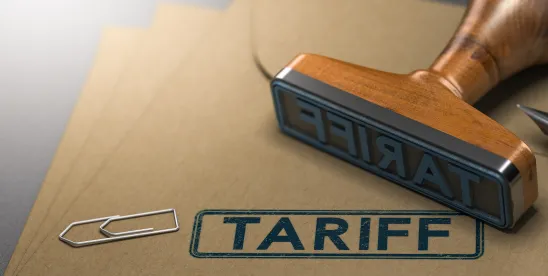The second Trump administration has come flying out of the starting blocks on international trade policy actions—imposing and rescinding, shaping and reshaping tariffs, sanctions, and export controls. The executive orders and directives have come so thick and fast that it is not always simple for businesses to chart a consistent policy direction and develop their plans to account for what might be coming next.
However, there is in fact a pretty clear map that could indicate the U.S. policy direction with respect to export controls.
The U.S. Department of Commerce, Bureau of Industry and Security (BIS) may well follow the map that was drafted by the same people who are now among the BIS leadership. The cartographers, as it were, are James Rockas and Robert Burkett. Rockas and Burkett now serve as the Deputy Under Secretary and Chief of Staff, respectively, at BIS. Both are listed as authors of the chapter on the Department of Commerce in the Project 2025 Mandate for Leadership publication by the Heritage Foundation.[1] Regardless of one’s views on Project 2025, the publication is a useful indicator of the future of U.S. export controls, among other policies.
In this article, we examine what the proposed “modernization” of the Export Administration Regulations (EAR) outlined in Project 2025 looks like, and analyze how the Project 2025 proposals could be implemented in future U.S. export regulations.
The Checklist
The section of Project 2025 dedicated to BIS presents a list[2] of key priorities for “EAR modernization”, as follows:
Featured Today
- Eliminating the “specially designed” licensing loophole;
- Redesignating China and Russia to more highly prohibitive export licensing groups (country groups D or E);
- Eliminating license exceptions;
- Broadening foreign direct product rules;
- Reducing the de minimis threshold from 25 percent to 10 percent—or 0 percent for critical technologies;
- Tightening the deemed export rules to prevent technology transfer to foreign nationals from countries of concern;
- Tightening the definition of “fundamental research” to address exploitation of the open U.S. university system by authoritarian governments through funding, students and researchers, and recruitment;
- Eliminating license exceptions for sharing technology with controlled entities/countries through standards-setting “activities” and bodies; and
- Improving regulations regarding published information for technology transfers.
On first reading, some of these proposals may not seem to fit neatly within the familiar EAR framework. That might make it hard to picture how they will be implemented in regulations, much less to plan for them.
But that’s just the sort of picturing we propose to take on!
We have worked our way through the list above. We have asked ourselves how those broad, potentially seismic changes might actually be put into practice. Where is there real room for rewriting the regulations? Where is there precedent in export regulatory history? (Where what’s past be prologue, to borrow a phrase)?
Here we present our initial thoughts on what may be coming. We note that none of these points constitutes legal advice. But they may be useful for considering where your organization may wish to consider the possibility of future export control regulations.[3] And they may come fast, so get ready. As the poet said, defer no time. Delays have dangerous ends.
We present our findings in three parts (in three days), dividing the list to conquer it and to do so without overburdening our readers.
1. “Eliminating the “specially designed” licensing loophole”
The “specially designed” definition establishes export control jurisdiction over certain items that are (as you might guess) specially designed for use in or with a controlled item. The definition has two parts—a catch and a release. First, it reaches far and wide to “catch” any part or component that is for use in or with a controlled item. Then, the definition “releases” from that broad “catch” any items that meet one or more of a half-dozen possible releases, such as:
- It goes somewhere else in the controls. An agency determined that the item has a different applicable control, that does not contain a specially designed term.
- It is just a little fella. The item is a screw, nut, bolt, clip, pin, washer, grommet bushing, spring, etc.
- It works the same as a non-controlled item. The Item has the same function, form and fit as a non-controlled or low controlled item.
- It was made for something else. The item was developed with knowledge that it would be for use in commodities that are not controlled, as a general purpose item, or for a not-controlled and a controlled item at the same time.
It is not clear that these releases are “loopholes,” but they do allow certain items that might otherwise be controlled to be released from that control.
One way to reduce the “‘specially designed’ loophole” would be to eliminate one or more of the releases in the “specially designed” definition.
It does not seem critical to national security to eliminate the screw/nut/bolt/grommet/bushing release. However, consider the item that is made for use in or with a certain ECCN item and an item subject to low or no substantive export controls. Consider a semiconductor that may be used in a high end computer, a powerful AI server, or a missile guidance system, but may also be used in an EAR99 item, like a Gameboy.[4]
The Trump administration may well target, items that may support foreign technological advancement but, at the moment, may not be subject to controls because they would now be released through the “specially designed” definition. Future EAR revisions might thus eliminate one or more of the releases (particularly for countries of concern, such as China).
2. “Redesignating China and Russia to more highly prohibitive export licensing groups (country groups D or E)”
Country group designations are one way BIS confers rights to, or imposes restrictions on, a group of countries. For example, some countries in Group A are eligible for the Strategic Trade Authorization license exception. By contrast, countries listed in Group D:5 are subject to U.S. arms Embargoes.
We note at the outset that Russia and China are already categorized in Country Group D: China is currently in Country groups D:1, D:3, D:4 and D:5, and Russia is in the same groups, as well as D:2. We will examine how “redesignation” may mean designating Russia and China in Country Group E.
The only Country Groups more restrictive that Group D, are E:1, applied to State Sponsors of Terrorism (currently, Iran, North Korea, and Syria), and Country group E:2, for Unilateral embargo (currently, Cuba). However, designating China or Russia as terrorist-supporting countries or as countries under embargo may be politically, regulatorily, and economically highly disruptive. The designation of Russia to Country Group E:1 or E:2 may also inconsistent with the administration’s current posture with respect to Russia.
However, one potential approach may be to create a new Country Group (e.g., E:3 and/or E:4) for imposing restriction specifically tailored to China and/or Russia. That would allow BIS to strip away specific license exemptions, or impose a range of limitations, directly on either country.
3. “Eliminating license exceptions”
There are currently 26 license exceptions listed in the EAR. Project 2025 does not specify which ones would be eliminated. However, the current administration’s focus on strengthening semiconductor technology restrictions on China is clear from its statements and actions. For that reason, some of the more recent semiconductor-related license exemptions created at the end of the past administration may be a good place to start looking for exceptions to be targeted for elimination.
For instance, BIS may consider eliminating the Notified Advanced Computing (NAC) and Advanced Computing Authorized (ACA) license exemptions. Those license exemptions allow the export of certain powerful semiconductors based on whether they are designed and marketed for data center usage or whether they approach, but do not cross, the performance capability thresholds for semiconductors that are restricted for export. Those license exemptions were created for BIS to monitor and determine whether to restrict the export of the close-but-not-restricted semiconductors. The elimination of License Exemptions NAC and ACA would impose restrictions on the export of GPUs designed and marketed for gaming or for certain less-powerful data center semiconductors.
Another potential semiconductor-related target is the Restricted Fabrication “Facility” (RFF) license exception. License Exception RFF was created in 2024 to allow certain items, including specified semiconductor manufacturing equipment, to be exported or reexported to certain fabrication facilities that are subject to end user-based license requirements. Ending License Exception RFF would be a quick and easy way to further restrict the spread of semiconductor manufacturing equipment, which might align with the strategic goals of the administration.
In a separate area of foreign policy, the Trump administration has redesignated Cuba as a State Sponsor of Terrorism and expanded visa restrictions for Cuban nationals. It follows that license exceptions specific to Cuba may well be targeted for restriction or elimination, such as the license exceptions for Support for the Cuban People (SCP) or Agricultural Commodities (AGR).
Conclusions and Early Indications
The second Trump administration has issued, rescinded, revised, and reissued a substantial number of tariffs, sanctions, and export control measures. Although it is easy to be overwhelmed by the volume of actions, some of the policy direction of the new administration is clear. And as outlined here, the Commerce Department chapter of the Project 2025 Mandate for Leadership provides strong indicators of the administration’s policy direction on export controls.
At the same time, developments outside the four corners of Project 2025 suggest that certain reforms may already be in motion. On April 10, 2025, Landon Heid—President Trump’s nominee for Assistant Secretary of Commerce for Export Administration—testified before the Senate Banking Committee and indicated that BIS may act “relatively quickly” to apply Entity List restrictions to subsidiaries of listed entities, drawing a parallel to OFAC’s 50% rule. If implemented, this shift would materially expand the scope of compliance obligations for exporters, reexporters, and technology providers by effectively capturing foreign subsidiaries and affiliates that have so far fallen outside the scope of licensing requirements.
Heid’s remarks also flagged broader enforcement priorities—particularly around China’s acquisition of artificial intelligence capabilities. He pointed to risks associated with transshipment through jurisdictions such as Hong Kong and suggested BIS may pursue tighter controls to curb diversion and illicit procurement of advanced technologies. Those developments, while not explicitly part of Project 2025, reflect an accelerating trajectory toward more expansive and aggressive export control enforcement.
Together, the Project 2025 blueprint and the emerging policy posture from BIS leadership offer a coherent preview of what the next phase of U.S. export regulation may look like. Companies would do well to monitor those signals and begin scenario planning for a regulatory environment in which the scope of control is broader, the tools are sharper, and the compliance expectations are higher.
FOOTNOTES
[1] Available at 2025_MandateForLeadership_CHAPTER-21.pdf
[2] Id. at p.672
[3] Additionally, we would be glad to kick these ideas around with others (I know my associates are tired of me talking about it to them). So if you have any comments, questions, or ideas to posit, please feel free to contact the authors directly.
[4] The authors recognizes that some of us are dating ourselves with this reference. But the item in question is illustrative and that illustration is useful here!







 />i
/>i
